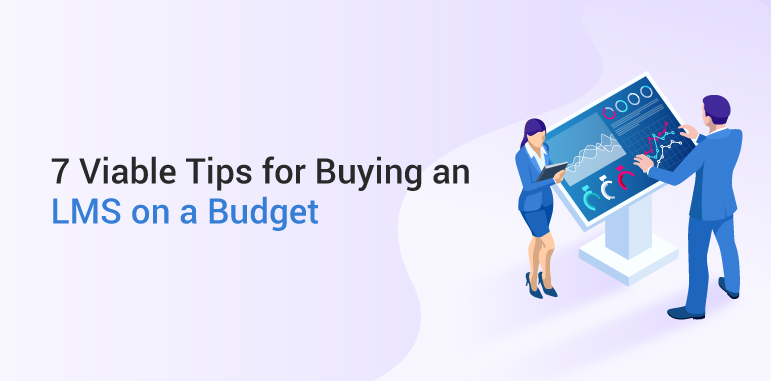Buying a Learning Management System with a limited budget is a challenge. It is difficult enough to find an LMS product that will work how you want it to, but then if you throw in the added element of “low-cost”, and you will find yourself in a tricky position. To help you along this journey, we have compiled some tips that you can use that might make this problem seem more solvable.
Tip 1: Set a Budget
Before you even start searching for products, finalize on your budget. It isn’t always so simple because nobody really knows what a Learning Management System should cost. Planning for a budget LMS or a low-cost one is not enough because that is a very commonly used term. Instead of asking “what is my budget”, try to plan an approximate investment amount that you would make on that project for a year. The best method to plan these investments is by reaching out to LMS providers with a total count of expected users on the platform and most will be happy to give you an estimated budget.
Tip 2: Build Your Own Feature List
Downloading an “LMS Buying Guide” or “Sample Feature Sheet” isn’t the best advice for every perspective LMS buyer, but it is handy for organizations looking to save some money. Instead of starting with a massive list of features and then removing what you might not need, build a feature list yourself. Think long and hard about what features you really expect to use in the next 12-18 months and focus on those. For example, if you do not have any visibility of needing an “offline mode”, leave it off your list.
Tip 3: Narrow Your Feature List
Now that you’ve got a list of features that are important to you, it is time to determine HOW important they are to you. Instead of rating them from 1-10, we recommend using three tiers (high, medium, low) that represent how critical that feature is for your business. This is important because many LMS have seemingly unlimited features, many of which you will never use, but you are certainly paying for them in one way or another.
Tip 4: Focus on What Matter Most
After sorting your feature list by highlighting the most critical ones, you can start collecting information from LMS providers. We recommend you start with a very simple request that includes key features and user-count because you’ll need to quickly remove all players that fall outside your budget. This affirms your notion of considering the features that you require, and the LMS provider with whom you are going to partner with is prioritizing your needs.
Tip 5: Demo Critical Features
LMS providers showcase their most innovative features during a product demo to get you excited about the possibilities of working with them. However, it is rare that those features are what you really need. Be very specific with the LMS providers that you want to see the features that are critical to your business first and foremost. This helps to remove any bias you might have in selecting a vendor that has the MOST/BEST features, but NOT the features that are best for you.
Tip 6: Be Transparent with Negotiations
Any purchasing decision involves a price negotiation and both the parties strive to get the best price. All of them are successful in their own ways, but what cuts across all these that will give you the best price is transparency. Not about what your bottom-line number is, but transparency about how and when you intend to buy. If you say you will decide in two days, stick to it. If you aren’t the sole decision maker, be transparent about it. You would be surprised to know the authority a salesperson has in getting a discount, so being transparent is certainly a good choice.
Here’s a great line you can use if you have already selected the LMS you want to go with, but the price is still a little higher than anticipated; “If you can drop the price down to $XXX, I can sign the contract this Friday”.
Tip 7: Be Realistic
Possibly the most important tip of all, is to have the right expectations in your mind. You would not go to a car lot and expect a Ferrari for $10,000, so do not put similar expectations on your purchase of a Learning Management System if you are on a budget. You will more than likely have to concede on a couple of items, but as long as you’ve identified what you aren’t willing to let go of, you can rest easy knowing that you’ve purchased the LMS that is the right fit for your business.
Finding an LMS to match your budget is not as difficult as it sounds. Many of these tips are quite simple to follow and would not take you much time to implement. Even with an unlimited budget, many of these tips can help remove bias from your purchasing decision that would have made you pay more for an LMS that might end up not working for you in the first place. To better understand about outsourcing L&D, read the free guide: How to buy Learning and Development to learn the 6-step procedure on selecting and managing third party L&D partners.





